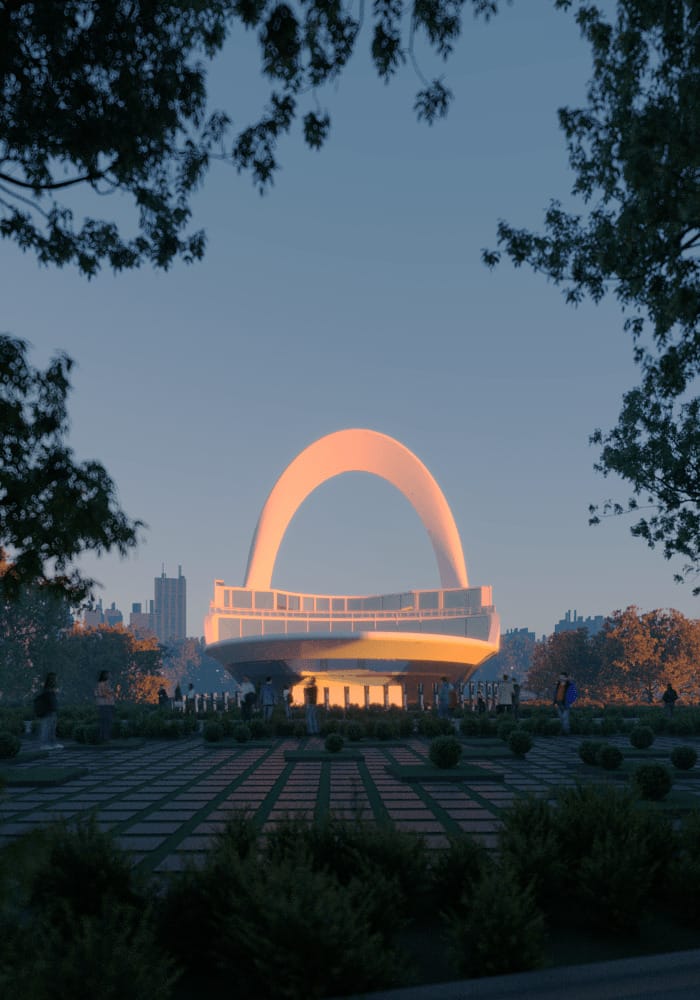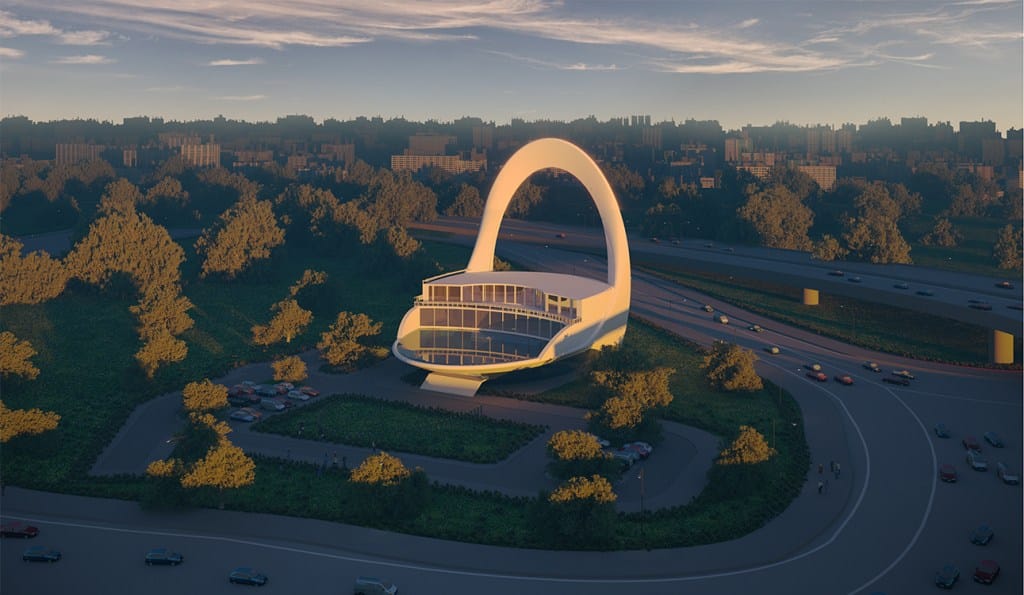Al-Falak Mosque
New Mosque near Preston, Lancashire, UK.
فَإِذَا رَكِبُواْ فِى ٱلْفُلْكِ دَعَوُاْ ٱللَّهَ مُخْلِصِينَ لَهُ ٱلدِّينَ فَلَمَّا نَجَّىٰهُمْ إِلَى ٱلْبَرِّ إِذَا هُمْ يُشْرِكُونَ
In this project, we would like to introduce a brave new design called Parametricism, based on computational design. This place of worship is of a bold and sculptural curvy form, making a statement to both visitors and worshippers. Its tall arch representing the minaret with a clear focal point; it is designed to be a unique place of worship with a contemporary approach for a multicultural society and the landmark of Preston for years to come.
The form of this visually prominent building has been carefully chosen: a ship, which has a specific meaning in Islam:
Do you not see that ships sail through the sea by the favor of Allah that he may show you of his sign?
Al Quran 31:31
Client
RIBA
DATE
1-6-2021
Location
UK
Type
Modern – Organic Architecture

project team: Ibrahim N Joharji, Waliporn Nkapan
And when they embark on a ship, they invoke Allah, making their Faith pure for Him only, but when He brings them safely to land, behold, they give a share of their worship to others.
Al Quran 29:65
This mosque building is, therefore, a sign, an embarkment of faith, a safe haven, a spiritual journey to all worshippers.
We do not claim that the design has totally met what has been described in the design guideline. In fact, the additional information including the site redline, contours, Q&A, suggestive floor plans, were provided to us quite late. However, we are happy to see that the design has met at least 80 percent of what is expected and can be further developed.
The design takes advantage of the prominent location. The building can be viewed from all angles, but still visually navigable through its spatial communication. The visitor should be able to locate its access from afar. The site access on D’Urton Lane is kept, but the route to the plateau is adjusted. The location of the building footprint is placed differently from the one on the suggestive floor plan. But we think that it is better this way because 1) the drop-off can be done immediately after reaching the platform, 2) the main prayer hall can face the Qibla direction without any visual obstacle, and 3) with the building placed on one corner of the site, the external space is optimized for external courtyard and parking purposes.
The building has a total of 2,382 sq.m. It was intended to be 3 floors, but an additional floor is added for an access purpose. We try to keep the upper 2 floors as horizontal as possible in the scheme, as opposing to the tall arch representing the minaret. The ground floor of 862 sq.m. is the main prayer hall. It has a large curved curtain wall, representing the mihrab, which guarantees maximum natural light. It can accommodate up to 410 prayer mats. A sub entrance can also be found on the ground floor. The first floor is the lobby floor (377 sq.m.) with access from the internal street. The drop off is covered by the overhanging shape of the building. The visitors are welcomed in a large lobby with skylight covered by a space frame. The related functions such as a reception desk, an office, a cloak room, and an ablution area are provided. The second floor of 392 sq.m. is the Lady’s prayer hall with its own ablution area, and a childcare facility. It is positioned on top of the main prayer hall with a concave glazed wall in order to provide clear views into it. The third floor of 753 sq.m. is the library floor with other supporting functions such as an ablution area, a meeting room, and a community room. All spaces are flexible.
The vertical circulations are found on the perimeter of the building so that the space of the main prayer hall can be kept clear. The staircase down to the main prayer hall is found on the right, one to the lady’s prayer hall on the left, and the lifts are found towards the rear-left. Placed along the buildings’ curved geometry, the stairs have got unique curvy shapes with a subtle light flushing against the curved wall.





The building structure is concrete; its color is white. The material of the external cladding is GRC (Glass fibre-reinforced concrete), which is widely used to form exterior cladding panels of complex geometry. It can be formed into any shape and size. Another benefit of a GRC panel is its lightweight. It’s durability is more than 100 years without loss of tensile or flexural strength.
The interior of the building is to be kept simple and white and not ornate, as it is the best way to reflect its original shape. Indirect lighting can be used to flush the curvy walls. The natural sunlight can be maximized via its space frame roof and glazed elements. Some additional chairs such as twisted glass chairs that match the courtyard monoliths can be designed and custom made to fit the space.
In terms of landscape, it can be identified as two parts: softscape and hardscape. The hardscape’s main element is a plaza, which can be found right – opposite to the entrance of the building. It is of a half-ellipse shape with a paver pattern, surrounded by twisted concrete monoliths of different heights. These monoliths have got special meaning.
They have different angles at the base, but at the top they all turn facing South-east, towards Mecca city. The different heights and angles mean the people from different walks of life come together and join hands for the sake of the good. The monoliths themselves are also sundials; they give indication of hours of the day by sunlight acting upon them. The softscape are trees surrounding the perimeter of the sites as a buffer to wind and noise. Trees on the parking lot island where possible, provide shading to the cars.
The internal streets are designed in a straight line for engineering purposes. It is a one-way track with a main loop that allows coming back to the mosque building. The parking is provided as indicated with a minimum 140 spaces, blending in with the landscaping scheme. A cycle parking space is also provided.
Some say building is a work of art, this building could not be otherwise.
The design of mosques in a modern way and represents the new architectural development of mosque architecture and the new Islamic design. We were not lucky to win a prize in this architectural competition, but we are convinced that the phase that will enter into the new design of mosques is the share of such designs.



How can you reduce friction in a timely manner? Epidemics and make the crowds of worshipers safe. This is what we are looking for, because the Islamic architecture of mosques did not provide for decorations, and if we return to the origin of Islamic architecture, according to what Ibrahim Jawharji says, its origin is simplicity and true proportion to the Kaaba, and this is what we want to reach. All the existing decorations are Complementary elements and have nothing to do with the subject. Rather, the first mosques in Islam were made of clay and palm fronds.
The development of Islamic science and arts led to extravagance in decoration. We see that the construction of mosques does not stipulate two basic conditions for cleanliness and orientation towards the qiblah, and this is what We must innovate in it, imagine that this giant mihrab makes you know the direction of the qiblah from anywhere around the tidal, that in this is a consolidation of Islamic values and ease in explaining the Islamic purposes of the mosque and the house of worship, there is no need to hear the voice of God So, to know the time of the call to prayer, you can look and know the position of the qiblah with ease.


